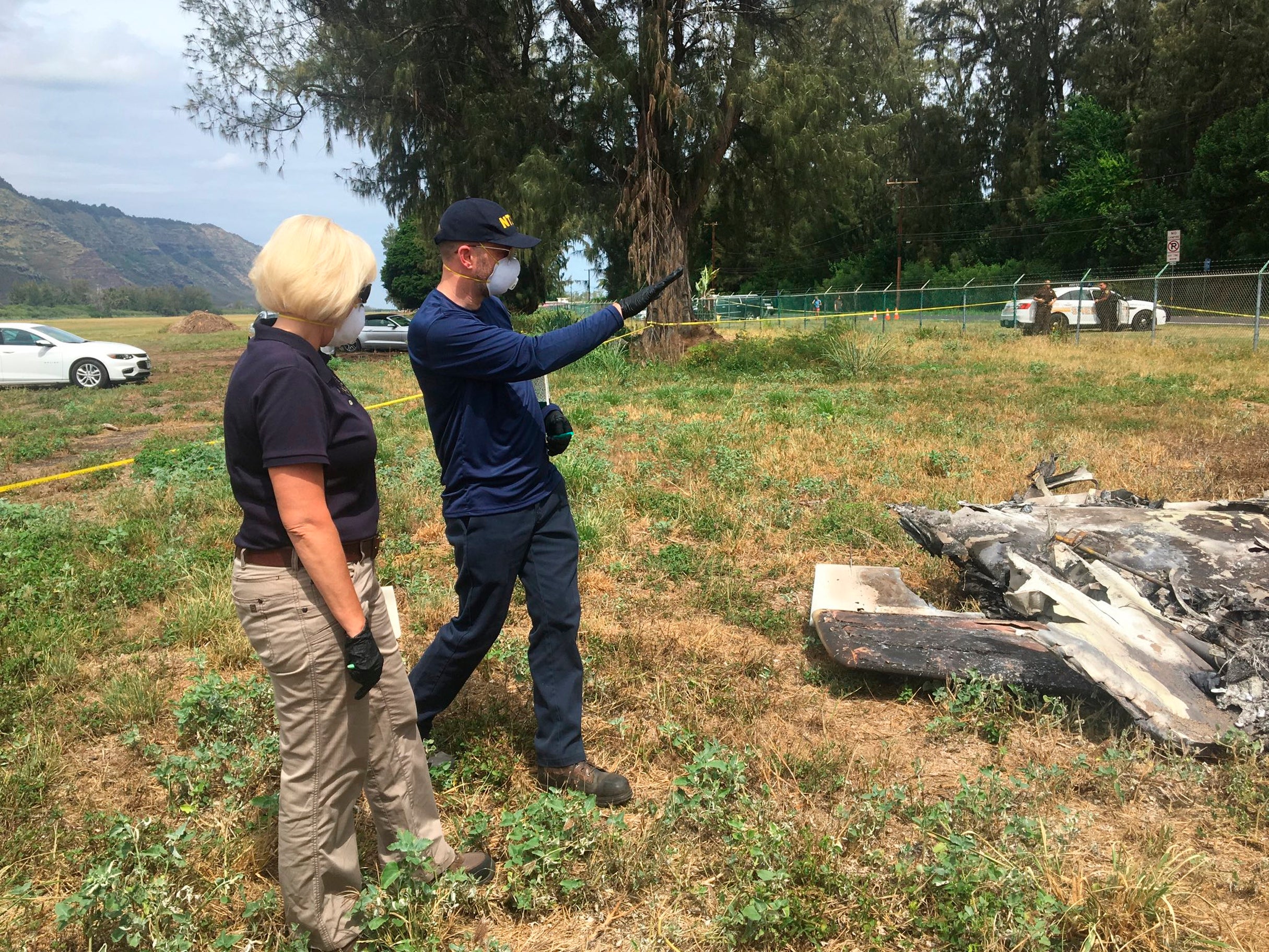Feds release details about deadly skydiving crash in Hawaii
Federal officials have released documents that provide details about a 2019 skydiving plane crash that killed 11 people in Hawaii

Federal officials released documents Wednesday that provide details about one of the deadliest civil aviation accidents of the past decade, including testimony from people who had varying accounts of the crash pilot’s flight habits.
The public docket contains reports from a National Transportation and Aviation Administration investigation into a 2019 skydiving plane crash that killed 11 people in Hawaii. The reports included testimony from witnesses and other pilots including Anthony “Tony” Skinner, a former pilot at the same parachute company, who said the accident pilot, Jerome Renck, sometimes flew aggressively and took risks that he wasn’t trained for.
Skinner said “Renck would bank hard and pitch up aggressively on departures, and he had seen him do that as a ‘thrill ride’ for the passengers,” the report said. ”The pilot would also do negative-G dives for the ‘weightless’ effect for fun, but he heard some jumpers would complain.
The former pilot said Renck, a French national who was the company's only pilot at the time of the crash, “told him he had done barrel rolls in the accident airplane, but not with passengers,” according to the report.
A tandem skydiving instructor for the skydiving operation, Bran Wagner, said he liked Renck's piloting.
“He said he liked flying with Jerome since he seemed to fly consistent and predictable each flight, which he liked in a pilot,” the report said. “He always expected a ‘pretty hard pull out,’ and all the flights were the same predictable flight path.”
Accounts from skydivers on previous flights were also included in the report.
“Takeoff was a little spicy for my liking but for the most part in control,” said skydiver Stephen Hatzistefanidis. “He definitely banked it a little hard on a high rate turn at a seemingly low altitude.”
A witness, Sayar Kuchenski, had taken part in skydives on the plane and flew on it the day before the crash.
In an email to the NTSB, Kuchenski said on previous flights “the pilot would sometimes take off at an extremely steep angle and aggressive climb right after leaving the runway. This was presumably done for fun to intentionally create a high-gravity environment momentary.”
Kuchenski asked the pilot not to fly in that manner because it could cause a stall, ”which would be unrecoverable that close to the ground. He respected my opinion and no longer flew the aircraft in that manner while I was on it after I had that discussion with him.”
Kuchenski asked the pilot not to fly in that manner because it could cause a stall ” which would be unrecoverable that close to the ground. He respected my opinion and no longer flew the aircraft in that manner while I was on it after I had that discussion with him.”
In a maintenance records report, Robert Seladis, a mechanic who performed maintenance on the aircraft, was interviewed a few days after the crash. FAA records showed that his certificates were revoked in 2005 due to falsification of records on two aircraft.
He was later allowed to be reexamined and a new certificate was issued in 2015. “Calls to Mr. Robert Seladis for a follow up interview were not returned,” the report said. “A letter sent to his last known address requesting a follow up interview was returned as no longer at this address.”
Seladis did contract maintenance on the airplane and was in possession of the aircraft logbooks, and attempts to retrieve those were unsuccessful, the report says.
The plane, which crashed on Oahu’s north shore on June 21, 2019, was the aircraft’s fourth of five scheduled skydiving trips that day.
The plane inverted shortly after departing a small coastal airport and crashed nose down next to a road. No one survived.
No cause for the crash was given in a preliminary report released by the NTSB in July 2019, but officials noted at the time that two skydivers made a last-minute decision to board the plane before it went down.
It was the deadliest civil aviation accident in the U.S. since a 2011 crash at an air show in Nevada killed 10 people.
In 2016, the same plane sustained substantial damage to its tail section while carrying skydivers over Northern California. The plane went into a diving spin and the skydivers struggled to get out of the plane. No one died.
Repairs were made to get the plane back into service before it was sent to Hawaii. The NTSB said in 2019 that they would review the repair and other records as part of their investigation.
The plane was being operated by Oahu Parachute Center. The company did not have the proper permits to take people skydiving at the time of the crash, according to documents released by the state.
The state reports said Oahu Parachute Center was “not in good standing” with the Department of Commerce and Consumer Affairs as of April 2019. It was also not a registered tenant for the state land it occupied at the airport.
The company's owner, George Rivera, was granted a permit in 2010 for a company under a different name — Hawaii Parachute Center — that allowed parachute repairs and rigging, but not skydiving operations.
Rivera left the business about 90 minutes before the fatal accident. He told investigators it was possible the pilot may have chosen to perform a more aggressive takeoff maneuver to show off since the “boss” wasn’t around.
The final seconds of the flight were captured by airport surveillance video and a witness reported the plane’s engines sounded normal before takeoff.
In the immediate aftermath of that crash, the NTSB called on the Federal Aviation Administration to tighten its regulations governing parachute operations.
The NTSB recommended to the FAA more than a decade ago that it strengthen its rules on pilot training, aircraft maintenance and inspection.